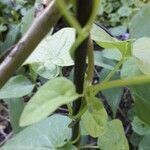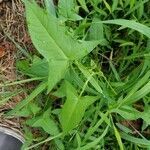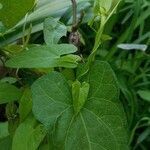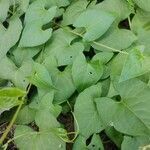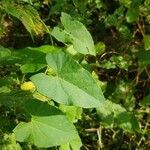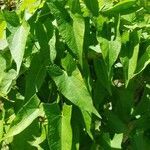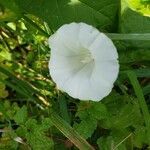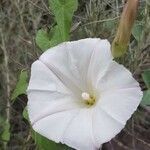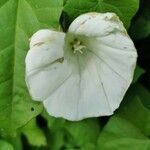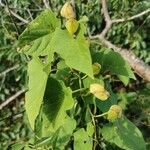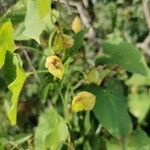Usually glabrous perennial herb. Stems terete, strongly twisting and climbing, 1-3 m long. Leaves triangular in outline, sagittate or hastate-sagittate, 40-120 mm long and 20-60 mm wide at base, apex acute or acuminate, basal lobes slightly divergent, obliquely truncate or acute, often almost angulate; petiole 10-50 mm long. Peduncles 1-flowered, longer than leaves; bracteoles ovate or ovate-cordate, acute or sub-obtuse, ±18 mm long, longer than calyx and almost concealing it. Sepals broadly lanceolate, very pale green, up to 10 mm long. Corolla funnel-shaped, white or pink, 50-55 mm long, with short obtuse lobes. Stamens 15-30 mm long; anthers 4.0-6.5 mm long. Capsule subglobose.
A slender climber. It keeps growing from year to year. It grows 1-4 m high. It has both underground stems or rhizomes and runners or stolons. It climbs over supports. The stems are smooth and twining. They twine in an anticlockwise direction. The leaves are 5-15 cm long and 2-4 cm wide. They are oval or triangle shaped or like an arrowhead. They are light green. The leaf stalks are almost free of hairs. The flowers are 5-8 cm long and about 4 cm across. They are white or pink and funnel shaped. They occur singly in the axils of leaves. They are on long stalks. The flowers open during the day and close at night. The fruit is a capsule about 1 cm across.
Rhizome far-creeping, branching; stems slender, up to ± 3 m. tall, sparingly branched. Petioles up to 10 cm. long. Lamina membr., glab. or nearly so, ± 5-10 × 4-7 cm., oblong-sagittate to hastate, acute or acuminate; cordate at base, sinus deep and narrow; lobes rounded to truncate. Peduncles long, us. narrowly winged; bracts large, ovate to ovate-lanceolate, enclosing subequal ovate-lanceolate sepals. Corolla ± 4-8 cm. diam., white or pink. Ovary incompletely 2-loculed; capsule c. 12 mm. diam., glab., apiculate. Seeds smooth.
Twining or occasionally trailing, to 3 m; lvs long-petioled, triangular to oblong in outline, hastate or sagittate, 5–10 cm; peduncles 5–15 cm; fls solitary; bracts ovate or oblong, 1–2 cm, commonly cordate at base; cor pink or white, 4–7 cm; 2n=22, 24. Thickets, shores, and disturbed sites; temperate regions of N. Amer. and Eurasia. We apparently have both native and intr. forms. Many confluent vars. have been described. (Convolvulus s.)
Glabrous climber to 3 m. Leaves hastate-sagittate. Flowers white or pink, 50-55 mm long, sepals broadly lanceolate; bracts ovate-cordate, longer than calyx.
